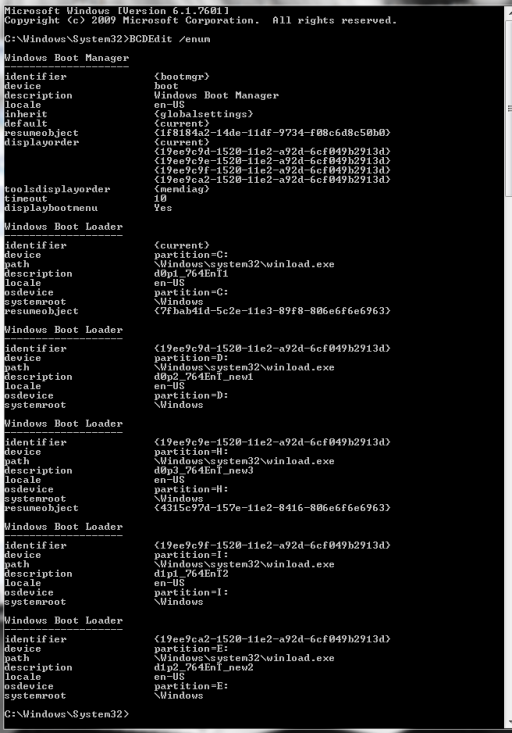mchldpy
Member
if i missed this when searching, sorry.
after choosing "select bcd store (in 'file') i edit it but when trying to save it, windows 7x64 tells me the file "xxx.tmp" in in use by... system, and won't let easybcd save the file back to the disk and partition it came from. then when trying to close easybcd windows gives the same message and i can't close easybcd unless i killl it in task manager but, i have to reboot windows to get it to release the .tmp file and after restarting there is nothing in the .tmp file (no suprise) BUT, there is no bcd in the disk/partition that i had selected in easybcd.
at this point i manually copied the bcd from disk0, partition1, to the other partitions (i tried this with easybcd more than once thinking the first time was a fluke) that were missing the bcd file. then i thought maybe i could use bcdedit to correct the order of the entries (if needed) but no matter which partition i open a command prompt in (Windows\System32) and type "BCDEdit /enum" it shows me the BCD file in disk0, partition1, which is the active system in use. i can't use easybcd to look at each BCD file, something is hanging it up. it works fine as long as i don't use "select BCD store" and i don't know if i can use bcdedit like i'm trying to. i'm running easybcd permanently as admin and each time i start it i select run-as-admin from the context menu. i'm not even sure if the bcd stores on the other disk/partitions should be different from the one in the first partition. i've included a scrnsht of the 'bcdedit /enum' result from the disk0, partition1, which is the one i'm on now.
all thisstarted after using vmware converter, vmware wrkstn 10 and acronis b and r 11.5 bootdisk when creating and recovering p2v and v2p the BCD was missing from the vir system and from the system it was made from. i don't know it it was me or a combo of all 3 and me or what.
sorry about being so looong winded,
michael clyde
easybcd 2.2
win 7x64 ent
hd0-wd640, hd1-wd500, hd2-wd320
after choosing "select bcd store (in 'file') i edit it but when trying to save it, windows 7x64 tells me the file "xxx.tmp" in in use by... system, and won't let easybcd save the file back to the disk and partition it came from. then when trying to close easybcd windows gives the same message and i can't close easybcd unless i killl it in task manager but, i have to reboot windows to get it to release the .tmp file and after restarting there is nothing in the .tmp file (no suprise) BUT, there is no bcd in the disk/partition that i had selected in easybcd.
at this point i manually copied the bcd from disk0, partition1, to the other partitions (i tried this with easybcd more than once thinking the first time was a fluke) that were missing the bcd file. then i thought maybe i could use bcdedit to correct the order of the entries (if needed) but no matter which partition i open a command prompt in (Windows\System32) and type "BCDEdit /enum" it shows me the BCD file in disk0, partition1, which is the active system in use. i can't use easybcd to look at each BCD file, something is hanging it up. it works fine as long as i don't use "select BCD store" and i don't know if i can use bcdedit like i'm trying to. i'm running easybcd permanently as admin and each time i start it i select run-as-admin from the context menu. i'm not even sure if the bcd stores on the other disk/partitions should be different from the one in the first partition. i've included a scrnsht of the 'bcdedit /enum' result from the disk0, partition1, which is the one i'm on now.
all thisstarted after using vmware converter, vmware wrkstn 10 and acronis b and r 11.5 bootdisk when creating and recovering p2v and v2p the BCD was missing from the vir system and from the system it was made from. i don't know it it was me or a combo of all 3 and me or what.
sorry about being so looong winded,
michael clyde
easybcd 2.2
win 7x64 ent
hd0-wd640, hd1-wd500, hd2-wd320
Attachments
Last edited:

